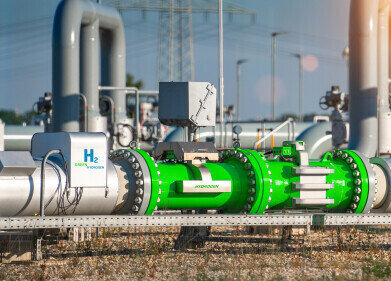Sustainable aviation fuel (SAF)
Energy Transition Guide - Fossil-based to Biobased Energy Sources
Jul 15 2022
The world is in the midst of an energy crisis and fossil fuels are the heart of the problem. Not only do they release large quantities of carbon dioxide and other greenhouse emissions into the atmosphere when burned, but reserves of coal, oil and natural gas are drying up. As non-renewable resources, supply isn’t infinite. Eventually demand will outstrip supply and when it does, the world will need an alternative source of energy. Cue the energy transition.
Concerns over climate change and global energy security have prompted governments, energy giants and key decision makers around the world to embrace biobased energy sources. The switch to these renewable, eco-friendly alternatives is known as the energy transition.
Financial information and analytics giant S&P Global describes the energy transition as “the global energy sector’s shift from fossil-based systems of energy production and consumption - including oil, natural gas and coal - to renewable energy sources like wind and solar, as well as lithium-ion batteries.”
What’s driving the energy transition?
Before we dive deeper into what types of fuels will step up as replacements for coal, oil and natural gas, let’s take a look at the key factors driving the energy transition.
-
Climate change concerns
Every year, burning fossil fuels releases billions of tonnes of CO2 into the atmosphere. The natural gas actively absorbs and emits heat and is a key contributor to climate change. Around the world, environmental scientists cite CO2 as a key driver of global warming. Rising temperatures contribute to devastating events like long periods of drought, intense summer wildfires, intense tropical storms and rising sea levels. The urgent need to reduce CO2 emissions and curb global warming is arguably the most important driver of the energy transition.
-
Dwindling supplies of oil, coal and natural gas
It’s no secret that supplies of fossil fuels such as oil, coal and natural gas are dwindling. Some analysts warn oil reserves could be depleted as soon as 2051, if consumption continues at the current pace. Supply is a pressing concern and a key contributor to the energy transition.
-
Advances in technologies
Over the past decade, technological advances have helped accelerate the energy transition. The development of electric batteries, solar panels and wind turbines has unlocked a new era of energy and offered a realistic alternative to fossil fuels.
-
Low price point of feedstocks
Unlike oil, coal and natural gas which are buried deep underground and difficult to extract, biobased energy feedstocks are often free or extremely affordable. Solar, wind and hydro power technologies harness free energy, while biofuels rely on feedstocks that are cheap and easy to produce. While there are challenges associated with scaling up production, many countries are supporting R&D projects designed to bring down production costs. The goal is to establish biobased energy sources as a competitive alternative to fossil fuels.
Introducing IRENA
Organisations like the International Renewable Energy Agency (IRENA) are spearheading the movement. The intergovernmental group offers support to countries transitioning to sustainable energy sources, including solar and wind, geothermal, bioenergy, hydro and ocean power. The organisation is an advocate for international cooperation and encourages countries to share knowledge and innovations in a bid to address climate change.
IRENA describes the energy transition as the following:
“The energy transition is a pathway toward transformation of the global energy sector from fossil-based to zero-carbon by the second half of this century. At its heart is the need to reduce energy-related CO2 emissions to limit climate change. Decarbonisation of the energy sector requires urgent action on a global scale, and while a global energy transition is underway, further action is needed to reduce carbon emissions and mitigate the effects of climate change. Renewable energy and energy efficiency measures can potentially achieve 90% of the required carbon reductions.”
A new era of biofuels
The Office of Energy Efficiency and Renewable Energy defines bioenergy as “one of many diverse resources available to help meet our demand for energy. It is a form of renewable energy that is derived from recently living organic materials known as biomass, which can be used to produce transportation fuels, heat, electricity, and products.”
What is biomass?
Biomass is an umbrella term used to describe matter derived from plant and algae materials. This includes urban food waste, as well as crop waste, wood waste, microalgae and residues from activities like forestry and agriculture. Biomass can also be derived from purpose-grown crops.
The potential is enormous, with a report published by the U.S. Department of Energy estimating the US has the capacity to produce up to 1 billion dry tons of biomass every year, without affecting supplied of food and animal feed. This biomass could be used to:
- Refine up to 50 billion gallons of biofuels that could be used to power cars, planes and other transport vehicles.
- Generate enough electricity to power millions of homes and small businesses.
- Produce 50 billion pounds of industrial chemicals and polymers, including cellulose fibres, fatty acids, fermentation products and non-food starch.
- Generate more than one million jobs.
- Add more than US$250 billion to the US economy.
Ethanol and biodiesel
The concept of biobased energy isn’t new. In fact, biofuels such as ethanol are widely used around the world. The renewable fuel is produced from starch-based biomass such as corn and sorghum. In the United States, most standard gasoline contains around 10% ethanol. The addition of ethanol is designed to minimise carbon dioxide emissions and reduce air pollution.
In the UK ethanol-containing fuel is labelled as E10 or E5, depending on ethanol percentage. E10 is compatible with 95% of all petrol-powered vehicles on British roads. The UK Department for Transport estimates that nationwide adoption of E10 could slash transport-related CO2 by a huge 750,000 tonnes a year. This translates to taking around 350,000 vehicles off British roads.
Exciting new biofuel feedstocks
Traditional feedstocks such as corn and sorghum aren’t the only way to distil biofuels. Below, we spotlight some exciting new biofuel feedstocks with enormous potential.
-
Landfill waste to hydrocarbon-based syngas
In Asia, clean energy company Fulcrum BioEnergy is spearheading a project to transform landfill waste into hydrocarbon synthetic gas. Also known as syngas, the multipurpose fuel is a blend of carbon monoxide (CO) and hydrogen (H2).
Working with petroleum giant SK Innovation, Fulcrum BioEnergy plans to launch the landfill-to-fuel in South Korea and other countries across Asia. The partnership comes on the heels of an announcement that the company’s Nevada-based Sierra BioFuels Plant, the first facility in the world designed to transform landfill waste into renewable transportation fuels, is now live. Equipped with both a feedstock processing facility and a biorefinery, the plant extracts carbon from the waste and transforms it into hydrocarbon-based syngas. The plant has the capacity to produce more than 10 million gallons of syngas a year, which can then be converted to renewable transportation fuel.
The technology is game changing, with Fulcrum's President and CEO Eric Pryor saying the plant simultaneously addresses two worldwide issues – the urgent need to reduce CO2 emissions and the global landfill crisis.
“Fulcrum's process will produce a fuel that is a cost-competitive sustainable aviation fuel and an alternative to petroleum-based fuel,” says Pryor. “With a net-zero carbon score and the ability to be produced in large volumes, our sustainable aviation fuel will have an impact on addressing climate change. We are eager to get this fuel into the market and into the hands of our airline partners.”
-
Food waste to jet fuel
The aviation industry is one of the biggest contributors to greenhouse gas emissions. The statistics are staggering, with a passenger on a roundtrip from London to New York City emitting almost 1000 kilograms of CO2. This is more than the average citizen of developing countries such as Nicaragua release in a year.
Derek Vardon, a scientist at the National Renewable Energy Laboratory (NREL), hopes to reimagine aviation emissions with decaying food waste. Using volatile fatty acids (VFAs) collected from organic waste, Vardon and his team created a yellow-tinged liquid that resembles kerosene, After being vaporised, the VFAs are percolated over zirconium oxide pellets, which transform them into longer chains called ketones. The ketones are sent to a second reactor where they’re bonded using platinum pellets, then stripped of oxygen atoms. The result is biobased jet fuel with a significantly lower environmental impact than fossil fuel-derived kerosene.
After publishing a paper in the Proceedings of the National Academy of Sciences, Vardon stepped up as chief technical officer of Alder Fuels, a sustainable aviation fuels (SAFs) start-up based in the USA.
“We have a limited window to impact climate change,” says Vardon. “I had to ask myself, ‘Do I want to write more papers or try to take this solution and get it into the marketplace?’”
The company has already signed a deal with United Airlines to purchase 1.5 billion gallons of fuel over the next two decades. Alder Fuels has also confirmed a partnership with Boeing. The leading commercial jetliner manufacturer will help the company test and qualify SAFs and ultimately, launch its products on the global stage.
“As we work toward the civil aviation industry’s commitment to net zero carbon emissions by 2050, we know that 700 - 1,000 times more SAF is needed in order to meet this goal,” says Sheila Remes, vice president of Environmental Sustainability at Boeing. “We also know that according to the U.S. Department of Energy, U.S. forestry and agricultural residues alone could provide enough biomass energy to generate enough SAF jet fuel to displace 75 percent of U.S. aviation fuel consumption. Partnerships like those with Alder enable us all to advocate for and scale SAF supply.”
-
Microalgae to biofuel
In an article published in the journal Fuel, the authors explore the use of microalgae biomass as a sustainable feedstock for biofuels. “One of the collateral benefits of integrating the use of microalgal technologies in the industry is microalgae’s ability to capture carbon dioxide during the application and biomass production process and consequently reducing carbon dioxide emissions,” write the authors.
To address the challenges associated with scaling up microalgae biofuel for industrial applications, the team explored the concept of a microalgae-based biorefinery. The facility would not only cultivate and harvest microalgae but genetically modify cells to create a “fourth generation” of biofuel. This cell disruption process would allow biorefineries to maximise yield, minimise production costs and market microalgae biofuel as a competitive alternative to fossil-based fuels.
Want to know more about the latest alternative energy developments? Check out the article 'Latest advances in Artificial Photosynthesis: a hidden gem in the realm of alternative energy technologies'.
Digital Edition
PIN 26.1 Feb/Mar 2025
March 2025
Analytical Instrumentation - Elemental Analysis for Quality and Process Control at Refineries, for Lubricants and Wear Metals in Engine Oils - Synthetic Lubricants: New Developments - Scaling...
View all digital editions
Events
Apr 08 2025 Birmingham, UK
Apr 08 2025 Kielce, Poland
Apr 08 2025 Ravenna, Italy
Apr 08 2025 Southampton, UK
Apr 08 2025 London, UK
.jpg)


















